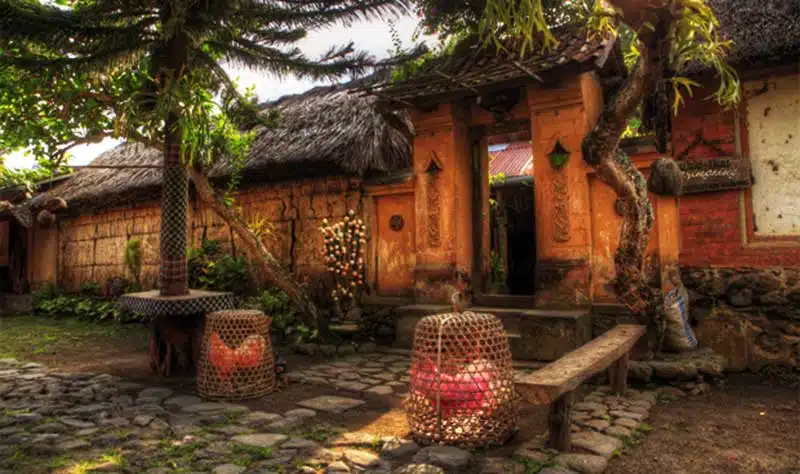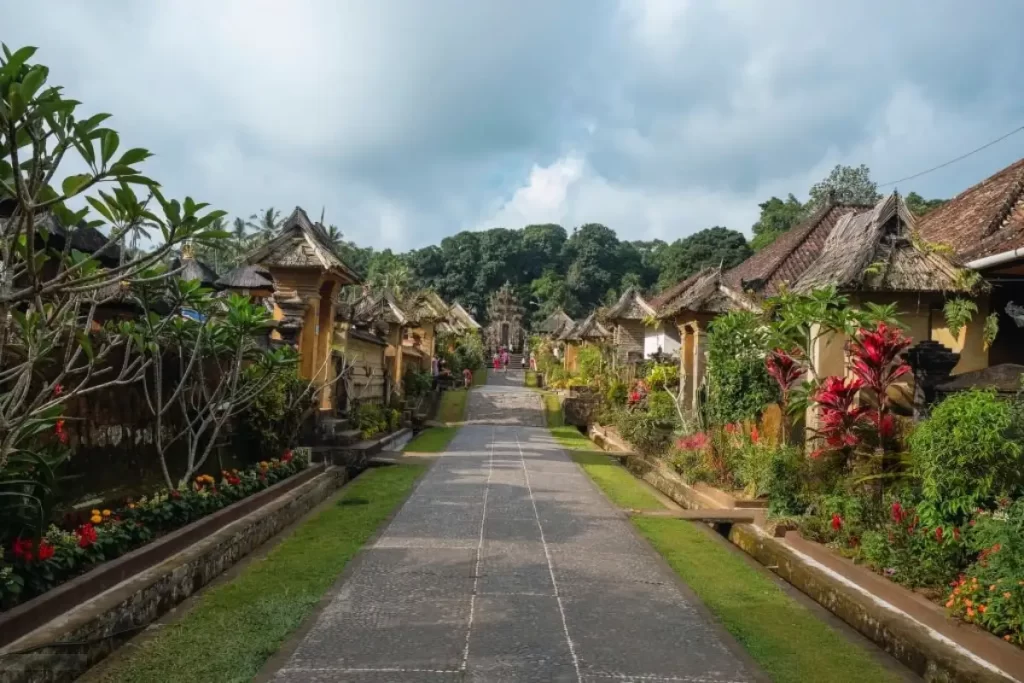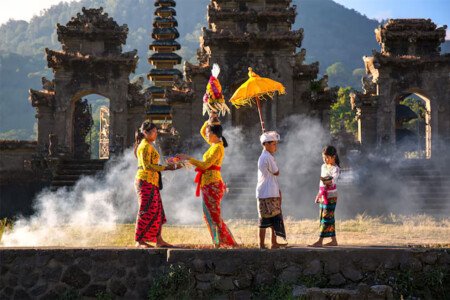Article Highlights
Cultural Heritage Preservation: Bali’s traditional villages maintain centuries-old customs, architecture, and social structures through strong community governance and religious practices rooted in Balinese Hinduism.
Tourism Integration Challenges: Villages face the delicate balance of welcoming visitors for economic benefits while protecting sacred spaces and preventing cultural commodification.
Community-Based Tourism Models: Successful villages implement visitor guidelines, local guide systems, and revenue-sharing programs that directly benefit residents while educating tourists about authentic Balinese culture.
Architectural Conservation: Traditional compounds (puri) and temples remain intact through strict building codes and community oversight, showcasing unique Balinese design principles.
Economic Transformation: Tourism provides alternative income sources beyond agriculture, enabling younger generations to stay in villages while contributing to cultural preservation efforts.
Sustainable Practices: Villages adopt eco-friendly tourism approaches, limiting visitor numbers, promoting responsible behavior, and maintaining environmental harmony essential to Balinese philosophy.
The Living Heritage of Bali’s Traditional Villages

Nestled among emerald rice terraces and tropical forests, Bali’s traditional villages stand as remarkable testaments to cultural resilience in an increasingly globalized world. These communities, known locally as “desa adat,” represent more than mere tourist destinations—they are living museums where ancient traditions continue to thrive alongside carefully managed modern influences. The challenge these villages face today is unprecedented: how to preserve their authentic cultural identity while embracing tourism as a vital economic lifeline.
The story of Bali’s traditional villages is one of adaptation without abandonment. For over a millennium, these communities have maintained their unique social structures, religious practices, and architectural heritage through a sophisticated system of customary law called “awig-awig.” This traditional governance framework has proven remarkably effective at managing both internal community affairs and external pressures, including the steady stream of international visitors drawn to Bali’s cultural authenticity.
The Foundation of Traditional Balinese Village Life
Traditional Balinese villages operate on principles that seamlessly blend the spiritual with the practical. The concept of “Tri Hita Karana”—the three sources of happiness—governs village life, emphasizing harmony between humans and God, humans and humans, and humans and nature. This philosophy manifests in every aspect of village organization, from the carefully planned layout of homes and temples to the intricate calendar of religious ceremonies that punctuate daily life.
The physical structure of these villages reflects their spiritual foundations. Each village centers around three main temples: the Pura Puseh (origin temple), Pura Desa (village temple), and Pura Dalem (death temple), representing the Hindu trinity and the cycle of life. Residential areas are organized according to traditional principles, with family compounds called “puri” featuring multiple buildings arranged around central courtyards. These architectural elements serve both practical and ceremonial purposes, creating spaces that accommodate large extended families while providing appropriate venues for religious rituals.
Village governance remains largely in the hands of traditional councils, typically composed of married men who have established their own households. These councils make decisions through consensus-building processes that can take considerable time but ultimately ensure community buy-in for important initiatives. This traditional democratic approach has proven particularly valuable when villages must decide how to engage with tourism while maintaining their cultural integrity.
The Tourism Transformation Challenge
The arrival of mass tourism in Bali, beginning in earnest during the 1970s and accelerating dramatically in recent decades, presented traditional villages with both unprecedented opportunities and existential challenges. Tourism brought economic diversification beyond the agricultural activities that had sustained these communities for generations. Suddenly, villagers could earn income through homestays, guided tours, traditional craft sales, and cultural performances.
However, this economic transformation came with significant risks. The commodification of culture—where sacred rituals and traditional practices become entertainment for visitors—threatened to hollow out the authentic meanings that gave these traditions their power and relevance for local communities. Some villages experienced rapid changes in social dynamics as young people abandoned traditional occupations for tourism-related work, potentially disrupting the intergenerational transfer of cultural knowledge.
The challenge became even more complex as different villages adopted varying approaches to tourism integration. Some embraced visitors enthusiastically, sometimes leading to overcrowding and cultural dilution. Others remained more restrictive, potentially missing economic opportunities that could support their communities. The most successful villages found ways to thread this needle, creating tourism experiences that genuinely benefited local residents while educating visitors about authentic Balinese culture.
Successful Models of Cultural Tourism Integration
Several Balinese villages have emerged as exemplars of sustainable cultural tourism, demonstrating that preservation and economic development can be mutually reinforcing rather than contradictory. These communities have developed sophisticated systems for managing visitor interactions that protect sacred spaces while creating meaningful cultural exchanges.
Penglipuran village in Bangli regency has become internationally recognized for its approach to cultural tourism management. The village maintains strict regulations about visitor behavior, including dress codes for entering sacred areas and designated paths that keep tourists away from the most private residential zones. Revenue from entrance fees and guided tours flows directly into community development projects, including traditional architecture preservation and educational programs for local youth.
Similarly, Tenganan village in Karangasem regency has managed to maintain its unique Bali Aga culture—one of the oldest Balinese cultural traditions—while selectively engaging with tourism. The village produces traditional textiles using ancient techniques, and visitors can observe artisans at work while learning about the cultural significance of these crafts. The community has established clear boundaries about which areas visitors may enter and which remain off-limits, ensuring that tourism enhances rather than disrupts village life.
These successful models share several common characteristics. They maintain strong traditional governance structures that can make and enforce decisions about tourism management. They invest tourism revenue back into cultural preservation activities, including traditional building maintenance, ceremony funding, and cultural education programs. They also prioritize quality over quantity in their visitor experiences, often limiting daily visitor numbers to prevent overcrowding and cultural disruption.
Preserving Architectural Heritage in the Modern Era
The architectural heritage of traditional Balinese villages represents one of the most visible and vulnerable aspects of cultural preservation in the tourism era. Traditional Balinese architecture reflects profound spiritual beliefs and practical wisdom developed over centuries of tropical living. The challenge lies in maintaining these structures and building principles while accommodating modern needs and tourism infrastructure.
Traditional Balinese buildings utilize locally sourced materials and construction techniques that create harmony with the natural environment. Thatched roofs made from alang-alang grass provide excellent insulation and weather resistance, while raised wooden structures allow air circulation and protect against flooding during monsoon seasons. The orientation and layout of buildings follow astrological and spiritual principles that create sacred geometries believed to promote harmony and prosperity.
Many villages have implemented strict building codes that require new construction to conform to traditional architectural principles. These regulations extend beyond mere aesthetics to encompass materials, proportions, and orientation requirements that maintain the visual and spiritual coherence of village environments. Some communities have established traditional building workshops where master craftsmen pass their knowledge to younger generations, ensuring that restoration and new construction projects maintain authentic techniques and standards.
The economic benefits of architectural preservation have become increasingly apparent as tourists seek authentic experiences in environments that clearly distinguish themselves from modern resort developments. Villages with well-preserved traditional architecture command premium prices for accommodation and tours, creating powerful economic incentives for continued preservation efforts. This has led to innovative approaches where tourism revenue directly funds architectural conservation projects, creating a sustainable cycle of preservation and economic benefit.
Economic Transformation and Community Development
The integration of tourism into traditional village economies has created complex patterns of change that extend far beyond simple income generation. Traditional agricultural activities, while still important, no longer represent the sole economic foundation for most villages that engage with tourism. This diversification has brought both opportunities and challenges that communities continue to navigate.
Tourism-related employment has provided opportunities for village residents to develop new skills while remaining in their ancestral communities. Young people who might otherwise migrate to urban areas for employment can now find meaningful work as tour guides, hospitality providers, craft producers, and cultural interpreters. This has helped maintain village populations and ensured continued participation in traditional community activities and ceremonies.
The economic benefits of tourism have enabled communities to invest in infrastructure improvements that enhance both resident quality of life and visitor experiences. Many villages have used tourism revenue to improve roads, water systems, and waste management facilities. Some have established community funds that provide low-interest loans for residents to start tourism-related businesses or improve their homes to accommodate visitors.
However, economic transformation has also created new forms of inequality within villages. Those residents with better English language skills, existing capital, or favorable locations for tourism activities have often benefited more substantially than others. Some villages have addressed this challenge by establishing revenue-sharing systems that ensure tourism benefits reach all community members, not just those directly involved in tourism activities.
Environmental Sustainability and Cultural Harmony
The relationship between environmental sustainability and cultural preservation in Balinese villages reflects the fundamental Balinese philosophy of maintaining harmony between human activities and natural systems. Traditional Balinese culture inherently emphasizes environmental stewardship through religious practices, agricultural systems, and settlement patterns that work with rather than against natural processes.
Rice terrace systems, known as “subak,” represent perhaps the most visible example of this environmental-cultural integration. These ancient irrigation cooperatives manage water resources through traditional religious and social mechanisms that have sustained agricultural productivity for over a thousand years. Many villages have found that tourists are fascinated by these systems, creating opportunities to generate income while maintaining traditional agricultural practices.
Forest conservation efforts in traditional villages often combine spiritual motivations with practical tourism benefits. Sacred forests surrounding village temples, known as “kahyangan jagat,” are protected through religious taboos that prohibit cutting trees or disturbing wildlife. These forests have become important attractions for eco-tourists while maintaining their spiritual significance for local communities.
Waste management has emerged as a critical challenge as tourism increases village populations and consumption patterns. Many communities have implemented innovative approaches that combine traditional environmental values with modern waste reduction techniques. Some villages have banned single-use plastics, established community composting programs, and created recycling initiatives that turn waste management into additional income-generating activities.
The Role of Traditional Governance in Modern Challenges
Traditional village governance systems have proven remarkably adaptable in addressing the complex challenges posed by tourism development. The customary law systems that have governed village life for centuries continue to provide frameworks for decision-making about tourism management, cultural preservation, and community development.
Village councils, known as “banjar” or “desa adat,” have expanded their traditional roles to encompass tourism-related issues. These bodies make decisions about visitor access to sacred sites, establish guidelines for tourist behavior, and determine how tourism revenue should be used for community benefit. The consensus-building processes traditional to these governance systems, while sometimes slow, tend to produce decisions that have broad community support and are more likely to be successfully implemented.
Many villages have created specialized committees to handle tourism-related issues while maintaining their traditional governance structures for other community matters. These tourism committees often include younger, more educated villagers who can interface effectively with tourism operators and government agencies while still operating within traditional decision-making frameworks.
The success of traditional governance in managing tourism has attracted attention from development practitioners and government officials seeking to understand how traditional institutions can effectively address modern challenges. Some regions have begun incorporating traditional governance principles into official tourism planning processes, recognizing that community-based management systems often prove more effective than top-down regulatory approaches.
Educational Initiatives and Knowledge Transfer
The preservation of traditional knowledge and cultural practices depends critically on effective systems for transferring this knowledge from older to younger generations. Tourism has created both challenges and opportunities for these educational processes, requiring villages to develop innovative approaches that maintain cultural authenticity while engaging with modern educational expectations.
Many villages have established cultural education programs that serve both local youth and visiting tourists. These programs teach traditional arts, crafts, cooking techniques, and religious practices through hands-on workshops that allow participants to learn by doing. Local masters in various traditional skills serve as instructors, ensuring that knowledge transfer occurs through authentic mentor-apprentice relationships that have characterized Balinese education for centuries.
Language preservation has become an important focus as Indonesian and English increasingly dominate daily communication in tourism-engaged villages. Some communities have established programs to teach traditional Balinese language and literature to local children while also offering basic language lessons to visitors interested in deeper cultural engagement.
Storytelling traditions that preserve historical knowledge and cultural values have found new life through tourism interactions. Village elders who serve as guides or cultural interpreters often share traditional stories with visitors, creating opportunities to practice and preserve oral traditions while generating income. Some villages have created formal storytelling programs that feature different traditional tales on different days, encouraging repeat visits while maintaining the cultural significance of these narratives.
Future Challenges and Opportunities
The long-term sustainability of cultural tourism in traditional Balinese villages depends on successfully navigating several emerging challenges while capitalizing on new opportunities created by changing global tourism patterns and technological developments.
Climate change presents both direct and indirect challenges for village-based tourism. Rising sea levels and changing precipitation patterns threaten agricultural systems that form the backdrop for many cultural tourism experiences. More frequent extreme weather events may disrupt tourism patterns and damage traditional architecture that requires regular maintenance with traditional materials and techniques.
Generational change continues to pose challenges as younger villagers gain access to global education and employment opportunities. While tourism has helped retain young people in villages, it has also exposed them to global lifestyle expectations that may conflict with traditional community obligations and practices. Villages must continue developing approaches that allow youth to participate in global culture while maintaining connections to local traditions.
Technology presents both opportunities and risks for traditional villages. Digital marketing and online booking platforms can help villages reach international tourists directly rather than relying on intermediaries. However, the pressure to maintain constant online presence and respond to digital communication expectations may conflict with traditional rhythms of village life and ceremony schedules.
The growing global interest in sustainable and authentic travel experiences creates opportunities for villages that have successfully maintained their cultural integrity while developing quality tourism offerings. Post-pandemic travel trends emphasizing smaller group sizes, longer stays, and meaningful cultural exchange align well with the community-based tourism models that many traditional villages have developed.
Conclusion: Balancing Preservation and Progress
The experience of Bali’s traditional villages in managing cultural tourism offers valuable insights for indigenous and traditional communities worldwide who face similar challenges of preserving cultural identity while engaging with global economic systems. The most successful villages have demonstrated that this balance is achievable through strong community governance, clear boundaries around sacred and private spaces, and tourism models that genuinely benefit local residents while educating visitors about authentic cultural practices.
The key to success appears to lie not in rejecting modernity or embracing it uncritically, but in selectively adapting modern opportunities to strengthen rather than undermine traditional community values and practices. Tourism revenue can fund cultural preservation activities, while visitor interest can motivate young people to learn traditional skills and knowledge. Modern communication technologies can help villages share their stories with global audiences while maintaining control over how their culture is presented and interpreted.
The ongoing evolution of these villages reflects the dynamic nature of culture itself. Rather than preserving static traditions unchanged from some idealized past, successful villages are demonstrating how traditional cultures can remain vibrant and relevant by adapting to contemporary challenges while maintaining their essential spiritual and social foundations. This approach offers hope not only for Balinese villages but for traditional communities everywhere seeking to maintain their identity in an interconnected world.
The story of Bali’s traditional villages and tourism continues to unfold, with new challenges and opportunities emerging as global travel patterns evolve and local communities gain experience in managing cultural tourism. Their success in balancing preservation and progress provides a model for sustainable cultural tourism that respects both visitor interests and community values, creating positive outcomes for all stakeholders involved in these remarkable cultural exchanges.











Join The Discussion